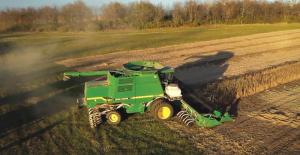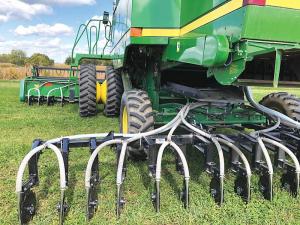He Drills Cover Crops While Combining
Max Pitt gets seed-to-soil contact planting cover crops with drill units mounted on a 9600 Deere combine. The Graceland University agricultural professor is on his second-generation prototype. It has worked well enough to apply for a patent on what he calls his Drill Combine.
The goal is a cost effective method of planting cover crops. His concept is an alternative to broadcasting from a combine, or making a separate pass with a tractor and drill requiring time and fuel.
“I figured we could use the combine to carry drill components and get better seed-to-soil contact,” explains Pitt. “I hoped we could get a better stand with less seed.”
Last November Pitt drilled rye at 30 and 50 lbs. per acre rates using single coulters. “Five months later we had between 600,000 and 800,000 plants per acre,” reports Pitt. “This fall we are testing 25 and 30-lb. rates of rye and also seeding about 6 acres to pennycress seed at about a 5 lbs. per acre rate.”
Pitt’s first Drill Combine used a Montag Mfg. seed tank and metering system. Its 30-cu. ft. tank was sufficient for about 50 acres drilling at this year’s lower rye rates. The tank mounts on the front axle.
He had toolbars fabricated by local welder/fabricator Steve Rollins. He used 4-in. square, 1/4-in. steel tubing for a 15-ft. bar mounted to the rear axle. It carries 12 single disc coulters on 15-in. spacing.
Six-ft. toolbars were mounted to each end of the 30-ft. soybean header. They carry 6 coulters each.
“Steve used steel pipe for the front toolbars that rotate inside sleeves attached to the header,” says Pitt. “This required a modified coulter mount, but it allowed me to raise and lower the drill units separate from the soybean header. This would be important if harvesting in wet conditions.”
Each pair of coulters was fed by a 1 1/2-in. flexible tube carrying seed from the Montag unit. The coulters loosened the soil and mixed the seed with it.
“I used old Deere drill openers, because they were the lowest cost coulters I could find,” says Pitt. “They created enough disruption in the soil that the seeds blowing in created seed-to-soil contact, with the residue spreader creating a degree of mulch over them.”
On his latest Drill Combine prototype, Pitt went with double disc coulters from Sunco Farm Equipment. He expected and has seen a much-improved seedbed.
“I’ve been very pleased with how they work,” he says. “You don’t want to drill too deeply, but better on the soil than on top of a leaf or other residue, as with simple broadcast systems.”
Pitt stayed with the Montag system. He notes that Montag has a long history of precision metering and placement of fertilizer.
Another change made this year was to adapt the Drill Combine to corn harvest. Instead of a dual rear/front system, Pitt is using 18 coulters on the rear toolbar to match his 8-row harvest swath. He lengthened the toolbar by adding 3-ft. hinged wings to each end. He moved 2 sets of double disc coulters from the front toolbar to the back and added 2 more. This covers the 8 rows with one coulter to either side of them. With the 4 sets of coulters on the soybean header, he still covers its 30-ft. width.
Pitt notes that his experimental units would not have been possible without the support of the Iowa Dept. of Ag, Montag Equipment, and Sunco Farm Equipment.
Contact: FARM SHOW Followup, Max Pitt, Graceland University, 1 University Place, Lamoni, Iowa 50140 (ph 641 442-5468; maxpitt@graceland.edu).

Click here to download page story appeared in.
Click here to read entire issue
He Drills Cover Crops While Combining COMBINES Miscellaneous Max Pitt gets seed-to-soil contact planting cover crops with drill units mounted on a 9600 Deere combine The Graceland University agricultural professor is on his second-generation prototype It has worked well enough to apply for a patent on what he calls his Drill Combine The goal is a cost effective method of planting cover crops His concept is an alternative to broadcasting from a combine or making a separate pass with a tractor and drill requiring time and fuel “I figured we could use the combine to carry drill components and get better seed-to-soil contact ” explains Pitt “I hoped we could get a better stand with less seed ” Last November Pitt drilled rye at 30 and 50 lbs per acre rates using single coulters “Five months later we had between 600 000 and 800 000 plants per acre ” reports Pitt “This fall we are testing 25 and 30-lb rates of rye and also seeding about 6 acres to pennycress seed at about a 5 lbs per acre rate ” Pitt’s first Drill Combine used a Montag Mfg seed tank and metering system Its 30-cu ft tank was sufficient for about 50 acres drilling at this year’s lower rye rates The tank mounts on the front axle He had toolbars fabricated by local welder/fabricator Steve Rollins He used 4-in square 1/4-in steel tubing for a 15-ft bar mounted to the rear axle It carries 12 single disc coulters on 15-in spacing Six-ft toolbars were mounted to each end of the 30-ft soybean header They carry 6 coulters each “Steve used steel pipe for the front toolbars that rotate inside sleeves attached to the header ” says Pitt “This required a modified coulter mount but it allowed me to raise and lower the drill units separate from the soybean header This would be important if harvesting in wet conditions ” Each pair of coulters was fed by a 1 1/2-in flexible tube carrying seed from the Montag unit The coulters loosened the soil and mixed the seed with it “I used old Deere drill openers because they were the lowest cost coulters I could find ” says Pitt “They created enough disruption in the soil that the seeds blowing in created seed-to-soil contact with the residue spreader creating a degree of mulch over them ” On his latest Drill Combine prototype Pitt went with double disc coulters from Sunco Farm Equipment He expected and has seen a much-improved seedbed “I’ve been very pleased with how they work ” he says “You don’t want to drill too deeply but better on the soil than on top of a leaf or other residue as with simple broadcast systems ” Pitt stayed with the Montag system He notes that Montag has a long history of precision metering and placement of fertilizer Another change made this year was to adapt the Drill Combine to corn harvest Instead of a dual rear/front system Pitt is using 18 coulters on the rear toolbar to match his 8-row harvest swath He lengthened the toolbar by adding 3-ft hinged wings to each end He moved 2 sets of double disc coulters from the front toolbar to the back and added 2 more This covers the 8 rows with one coulter to either side of them With the 4 sets of coulters on the soybean header he still covers its 30-ft width Pitt notes that his experimental units would not have been possible without the support of the Iowa Dept of Ag Montag Equipment and Sunco Farm Equipment Contact: FARM SHOW Followup Max Pitt Graceland University 1 University Place Lamoni Iowa 50140 ph 641 442-5468; maxpitt@graceland edu
To read the rest of this story, download this issue below or click
here to register with your account number.








